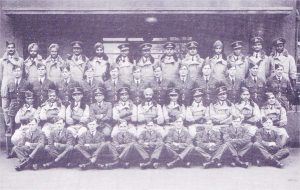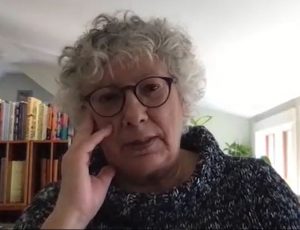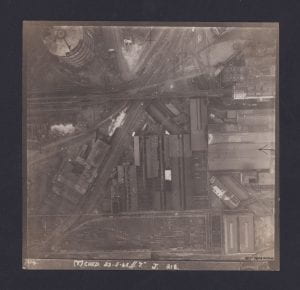Tribute for Windrush Day 2021: remembering ‘invisible’ RAF veterans
Some of those on the historic journey of MV Empire Windrush in 1948 were returning, rather than seeing the UK for the first time: veterans who had served with the Allies during the Second World War, especially in the RAF. It remains the case that they and other black and brown veterans are largely invisible in mainstream historical studies of the wartime RAF. Their stories are, however, acknowledged in studies such as Mark Johnson’s Caribbean Volunteers at War, Stephen Bourne’s The Motherland Calls, and Marika Sherwood’s Many Struggles.[1] Some wrote memoirs recording their experiences, among them Cy Grant, E. Martin Noble and Ralph Ottey.[2] There are ongoing projects, too, that seek to recover more personalities and experiences.[3]
Less remembered in the public imagination are the Maori crew who served in the RAF, or the few indigenous Canadians based in the UK with the Royal Canadian Air Force. Some 45 Maori aircrew have been identified, the majority of them serving in 75 (New Zealand) Squadron, based in Cambridgeshire. Several of these aircrew were decorated and one, Flying Officer Porokoru Patapu Pohe of 51 Squadron was shot down and taken prisoner at Stalag Luft III. His story featured in the movie The Great Escape; he was one of those recaptured and murdered. [4]
 There seem to be few traces of indigenous Canadians. The Royal Canadian Air Force, like the RAF, prevented all but those of ‘pure European descent’ from joining until 1940 and very small numbers seem to have volunteered as a result. Among them were James Ray Lightbown DFC, Jack Beaver, Willard John Bolduc DFC and Gib Whittamore.[5] Another is remembered in a poignant note written by veteran Phil James MBE on the back of a wartime crew photograph (above) in his possession: ‘I am on the far right, next to me is our W/AG [wireless operator/air gunner] a Canadian red indian [sic] JOHN YAKIMCHUCK, he shot himself, he could not cope with civilian life…’[6]
There seem to be few traces of indigenous Canadians. The Royal Canadian Air Force, like the RAF, prevented all but those of ‘pure European descent’ from joining until 1940 and very small numbers seem to have volunteered as a result. Among them were James Ray Lightbown DFC, Jack Beaver, Willard John Bolduc DFC and Gib Whittamore.[5] Another is remembered in a poignant note written by veteran Phil James MBE on the back of a wartime crew photograph (above) in his possession: ‘I am on the far right, next to me is our W/AG [wireless operator/air gunner] a Canadian red indian [sic] JOHN YAKIMCHUCK, he shot himself, he could not cope with civilian life…’[6]
Thousands were recruited into the RAF from South Asia. A celebrated group of 24 pilots arrived from India in 1940; most flew with RAF Fighter Command; they are pictured on the left .[7]
Yet there were many more. Some 200 Indians resident in Britain volunteered for the RAF [8] and according to the Open University’s ‘Making Britain’ database on South Asians in Britain from 1870 to 1950,
The Royal Air Force needed to make up a shortage in pilots by actively recruiting personnel from across the Commonwealth. It dispensed with the colour bar of the armed forces that stipulated that only ‘British subjects of pure European descent’ could join. After October 1939 people from across the Commonwealth, regardless of nationality or race became eligible to join the RAF. By the end of the Second World War, over 17,500 such men and women had been recruited, serving in a variety of roles. A further 25,000 served in the Royal Indian Air Force. [9]
Motivations for volunteering were many and varied – sometimes there was a strong family tradition of military service, sometimes there was a desire to escape and see the world. For most, fears of a return to enslavement should the Nazis emerge victorious were real.[10] Caribbean and African volunteers hoped to fly, yet Cy Grant’s observation that ‘things were not to work out exactly as I had expected’ [11] applied to the vast majority of the over 5, 000, who instead became ground personnel on RAF stations. As Jamaican Ralph Ottey, who trained at RAF Hunmanby Moor in 1944, recalls in his memoir,
My trade test was quite easy really. My tester told me:
- That there wasn’t much need for Air Gunners
- That there weren’t many vacancies for wireless operators
- There was a need for motor transport drivers
So that would be my trade … There was no point in arguing… [12]
Around 500 African and Caribbean personnel were accepted for aircrew training, mostly in RAF Bomber Command where the need was greatest. The expectation was that all these volunteers would leave at the war’s end; some managed to stay, while many more returned to the UK after brief periods ‘back home’, some on the Windrush. As has been well attested, they generally had a very rough time: ‘Black ex-servicemen confronted racist exclusions in the job market as well as the housing market’ and their war service was doubted.[13] This affected the way that they came to remember their war: the details of squadrons and stations were of less significance than the fact that they had served with pride and distinction.
One of the remarkable stories of ‘return’ is that of the Carby family, whose history has been traced by Hazel Carby in her award-winning study, Imperial Intimacies. In the late 18th century, the Carbys were living in the small village of Coleby, not far from the city of Lincoln. Several male members of the family joined the British army in the 1780s, possibly because of poor agricultural prospects.[14] One of them, Lilly Carby (‘Lilly’ was his mother’s maiden name), reached Jamaica with the 10th Regiment of Foot in 1789, but was soon discharged, possibly because of illness. He worked on various plantations before acquiring his own, which he called ‘Lincoln’. He named the enslaved people who worked for him, as well as his (known) children, after relatives in Lincolnshire,. Two of his children, William and Bridget, were born to a free woman of colour, Mary Ivey Mann; one, Matthew, was born to Bridget, an enslaved woman, in 1807 and though baptised, he was enslaved until abolition in the 1830s.
Four generations down Matthew Carby’s line, Carl Carby was born in Kingston in 1921. Although experiencing extreme poverty into his teens, he believed that education was his only means to social mobility and attended night school while working as the family’s main breadwinner. He was one of the first black Caribbean volunteers to be accepted for aircrew training in the early years of the Second World War. After completing his training in Jamaica and Canada, he was posted to RAF Coastal Command, later transferring to RAF Bomber Command. This transfer led to his being stationed at RAF Waddington, which is 2.4 miles from Coleby. Carl, who died in 2014, never knew how geographically close he had come to his origins; this only emerged during his daughter Hazel’s research.
Listen to an interview with Hazel Carby discussing her family history and her father’s RAF service, at https://ibccdigitalarchive.lincoln.ac.uk/omeka/items/show/32391.
Heather Hughes and Victoria Araj
[1] Mark Johnson, Caribbean Volunteers at War: The Forgotten Story of the RAF’s ‘Tuskegee Airmen’. Barnsley, Pen and Sword, 2014; Stephen Bourne, The Motherland Calls: Britain’s Black Servicemen and Women, 1939-45. Stroud, The History Press, 2012; Marika Sherwood, Many Struggles: West Indian Workers and Service Personnel in Britain 1939-1945. London, Karia Press, 1985.
[2] Cy Grant, A Member of the RAF of Indeterminate Race: World War Two Experiences of a West Indian Officer in the RAF. Bognor Regis, Woodfield Publishing, 2006; E. Martin Noble, Jamaica Airman: A Black Airman in Britain 1943 and After. London, New Beacon Books, 1984; Ralph Ottey, ‘Stranger Bwoy’ in the Royal Air Force in Lincolnshire 1944-1948. Boston, 2004.
[3] See for example https://www.africansinyorkshireproject.com/ and https://www.caribbeanaircrew-ww2.com/ [accessed 20 June 2021];
[4] Compiled from https://75nzsquadron.wordpress.com/maori-aircrew-who-served-with-75nz-squadron-39-45/ and http://rnzaf.proboards.com/thread/17780?page=2
[5] Compiled from BC/Yukon Command Military Service Recognition Book Vol X, obtainable from https://www.dropbox.com/sh/sfuwolxzqyfanq4/AAB-eDD5P7Kbs7-ayCrBnw_ka?dl=0 [accessed 21 June 2021]; Jack Farley’s story at http://www.bbc.co.uk/history/ww2peopleswar/stories/82/a2244782.shtml; and Native Soldiers, Foreign Battlefields. Veteran Affairs Canada, 2005.
[6] Letter from Phil James MBE to Sue Taylor, no date, IBCC project.
[7] See the contemporary footage at https://www.youtube.com/watch?v=QtLwn5sSmsI
[8] https://www.duhoctrungquoc.vn/wiki/en/India_in_World_War_II [accessed 21 June 2021]
[9] https://www.open.ac.uk/researchprojects/makingbritain/content/second-world-war-1939-1945
[10], Native Soldiers, Foreign Battlefields, p.22.
[11] Cy Grant, A Member of the RAF of Indeterminate Race, p.
[12] Ralph Ottey, ‘Stranger Bwoy’, p.3.
[13] Hazel Carby, Imperial Intimacies : A Tale of Two Islands. London, Verso, 2019, p. 240-41.
[14] Rex Russell, ‘Parliamentary enclosure, common rights, and social change: evidence from the parts of Lindsey in Lincolnshire’. Journal of Peasant Studies 27 (4), 2000, pp. 54-111.



